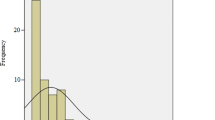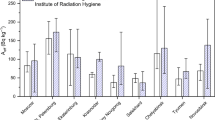Abstract
It is well known that most building materials contain traces of natural radionuclides. Exposure in dwellings depends on the concentration of building materials and soil down building. The aim of this study is to determine the activity concentrations of 226Ra, 232Th and 40K in materials and construction products used in the construction of a multistoried building in Peruíbe, São Paulo, Brazil by high-resolution gamma-ray spectrometry. The results show that the building materials analyzed present activity concentration within the range of average world values, except for clay bricks and sand. The building materials analyzed are within the recommended safety dose limit and do not pose any significant source of radiation hazard.
Similar content being viewed by others
Explore related subjects
Discover the latest articles, news and stories from top researchers in related subjects.Avoid common mistakes on your manuscript.
Introduction
Human beings are inevitably exposed to radiation from background sources. Radionuclides present in the Earth´s crust contribute to the population radiation exposure. According to the United Nations Scientific Committee on the Effects of Atomic Radiation, this contribution corresponds to 20 % of the average worldwide radiation exposure (2.4 mSv year−1) [1].
Knowledge of radioactivity levels in buildings is clearly of fundamental importance to the assessment of people exposure, since most of individuals spend most time indoors [1]. It is well known that most building materials contain traces of natural radionuclides. Materials derived from rock and soils contain mainly natural radionuclides of the uranium (238U) and thorium (232Th) series and the radioactive isotope of potassium (40K). In the uranium series, the decay chain segment starting from radium (226Ra) is of radiological concern and, therefore, reference is often made to radium instead of uranium. The worldwide average concentrations of radium, thorium and potassium in the earth’s crust are about 35, 35 and 400 Bq kg−1, respectively [1]. Exposure in dwellings depends on the concentration of building materials and soil down building. Building materials are an important source of indoor gamma exposure, especially in multistoried buildings, where the contribution of the soil radionuclides to the dwellers exposure is lower than at story houses.
Radiological hazard of natural radioactivity in building materials can be assessed through the hazard estimating models, such as radium equivalent activity (Raeq) and activity concentration index (I) [2, 3].
The aim of this study is to determine the activity concentrations of 226Ra, 232Th and 40K in materials and construction products used in the construction of a multistoried building in Peruíbe, São Paulo, Brazil (Fig. 1) by high-resolution gamma-ray spectrometry. These results were used to evaluate the activity concentration index (I) and the annual effective dose due to external gamma exposure for dwellers in order estimate the exposure risk arising due to the use of these materials.
Experimental
A total of 25 samples of building materials (red brick, cement, grout, clay brick and sand) were crushed and packed in 100 mL polyethylene flask and sealed for about 4 weeks prior to the measurement in order to ensure that the secular equilibrium has been reached between 226Ra and its short half-life decay products. It were analyzed five samples of each type of building material used in the construction of a multistoried residential building at Peruíbe, State of São Paulo, Brazil.
Activity concentrations of 226Ra, 232Th, and 40K in the samples of building materials were measured by gamma-ray spectrometry with a hyperpure germanium detector Canberra model GX2518 associated to a DSA1000 electronic module, comprising high voltage supplier and multichannel analyzer. The relative efficiency of the detector is 25 % and the effective energy resolution for the 1.33 MeV 60Co gamma transition is 1.9 keV. The detection efficiency curve was calculated for aqueous solutions containing certified activity concentrations of gamma-ray emitters covering a wide range of energies, encompassing the radionuclides energies determined in the samples. Background measurements were taken and subtracted in order to get net counts for the sample. Samples were measured during an accumulation time of 86,000 s. All spectra were analyzed with the Interwinner 4.0 of Eurisys Measurements Incorporation software for personal computer analysis of gamma-ray spectra from HPGe detectors. The activity concentration of 40K was determined directly by its own gamma-ray peak at 1460.8 keV, while concentrations of 226Ra and 232Th were calculated based on the weighted mean value of their respective decay products in equilibrium. The activity concentration of 226Ra was determined using the 295.2 and 351.9 keV gamma rays from 214Pb and the 609.3 and 1120.3 keV from 214Bi. The activity concentration of 232Th was determined using the 338.5, 911.1 and 968.9 keV photopeaks from 228Ac and the 727.2 keV photopeak from 212Bi [2].
Results and discussion
Activity concentration of radionuclides
Building materials samples were analyzed for 226Ra, 232Th and 40K activity concentrations. Table 1 presents the average results of concentrations and respective standard deviations, as well as the range of literature values [4–8] for the similar materials. Samples were collected and analyzed in triplicate.
Radiological parameters
Since the distribution of natural radionuclides in building materials is not uniform, a common radiological index, called Radium Equivalent Activity (Raeq), had been introduced to represent the specific radioactivity level of 226Ra, 232Th and 40K by a common index, which takes into account the radiation hazards associated with them [3, 9].
The radium equivalent activity was calculated based on the estimation that 1 Bq kg−1 of 226Ra, 0.7 Bq kg−1 of 232Th and 13 Bq kg−1 of 40K produce the same external gamma-ray dose rate.
where C Ra, C Th and C K are the activity concentrations of 226Ra, 232Th and 40K, respectively in Bq kg−1.
The activity concentration index (I) was calculated as suggested by the European Commission [10]:
where C Ra, C Th and C K are the activity concentrations of 226Ra, 232Th and 40K, respectively in Bq kg−1.
According to the European Commission recommendations, for materials used in bulk amounts (e.g. concrete), the activity concentration index (I) must be less than 1 and for superficial and other materials with restricted use, I must be less than 6 to keep the annual effective dose due to external exposure below 1 mSv year−1.
The indoor effective dose for external exposure due to building materials was performed following UNSCEAR procedures through the standard room concept, according to equation [1, 10]:
where E is the effective dose for external exposure, T is 8760 h per year, f is the fraction on time spent indoors (0.8), b is the conversion factor of absorbed dose in air to effective dose (0.7 Sv Gy−1), D R is gamma absorbed dose rate in air due to gamma ray emission from the natural radionuclides in the building material and m is the mass fraction of the building material in the standard room.
The gamma absorbed dose rate in air (D R) due to gamma ray emission from the natural radionuclides in the building materials is evaluated according the following equation [1]:
where q Ra, q Th and q K are conversion factors from activity concentration of 226Ra, 232Th and 40K, respectively to absorbed dose in indoor air (nGy h−1 per Bq kg−1) C Ra, C Th and C K are the activity concentration of 226Ra, 232Th and 40K, respectively in Bq kg−1.
The choice of the conversion factors from activity concentration to absorbed dose is the most important factor for evaluating the external dose from building materials. The gamma radiation from walls is strongly dependent upon wall thickness and density of building material, so it is useful to adopt the standard room concept to estimate the dose.
The q i values take into account the gamma transitions of 40K and of 226Ra and 232Th respective decay series, the wall thickness of the studied house and the density of building materials. In this work, values of q Ra, q Th and q K reported by European Commission [11] were used.
The calculations were performed considering an average of 50 nGy h−1 for the background [11].
Table 2 shows values of radiological hazard index and effective dose for external exposure.
The effective dose for external exposure due to building materials for dwellers in a residential building at Peruíbe, São Paulo, Brazil is 0.8 mSv year−1.
Conclusions
The activity concentrations of 226Ra, 232Th and 40K were measured by gamma ray spectrometry in building materials used for the construction of multistoried residential building in the cost of Peruíbe, State of São Paulo, Brazil. The results show that the building materials analyzed present activity concentration within the range of average world values, except for clay bricks and sand. The activity concentrations of 226Ra and 40K for clay brick and 232Th for sand are higher than the average world. Values of radium equivalent activity calculated for all the building materials measured are lower than the recommended maximum level of 370 Bq kg−1. Applying dose criteria recommended by the European Commission for building materials, four structural building materials meet the activity concentration index (I) less than 1 and only sand slightly exceeds this criterion. The effective dose for dweller due to external exposure was 0.8 mSv year−1, lower than the annual dose limit for general public of 1 mSv year−1 [12]. As a conclusion, the present study shows that the building materials analyzed are within the recommended safety dose limit and do not pose any significant source of radiation hazard.
References
UNSCEAR (2000) United Nations Scientific Committee on the Effects of Atomic Radiation, the 2000 report to the General Assembly with Scientific Annexes. United Nations, New York
Máduar MF, Campos MP, Mazzilli BP, Villaverde FL (2011) Assessment of external gamma exposure and radon levels in a dwelling constructed with phosphogypsum plates. J Hazard Mater 190:1063–1067
Estoková A, Palascáková L (2013) Assessment of natural radioactivity levels of cements and cement composites in the Slovak Republic. Int J Environ Res Public Health 10:7165–7179
Campos MP, Pecequilo BRS (2003) Exposure assessment due to building materials in ordinary houses at São Paulo, Brazil. Rev Bras P&D 5:60–65
El-Mageed AIA (2014) Natural radioactivity and radiological hazards of some building materials of Aden, Yemen. J Geochem Explor 140:41–45
Lu X (2014) Determination of natural radioactivity and associated radiation hazard in building materials used in Weinan, China. Radiat Phys Chem 99:62–67
Venturini L, Nisti MB (1997) Natural radioactivity of some Brazilian building materials. Radiat Prot Dosim 71:227–229
Righi S, Bruzzi L (2006) Natural radioactivity and radon exhalation in building materials used in Italian dwellings. J Environ Radioact 88(2):158–170
Turhan SX (2008) Assessment of the natural radioactivity and radiological hazards in Turkish cement and its raw materials. J Environ Radioact 99:404–414
Quindos LS, Newton GJ, Wilkening MH (1987) On the dose rate indoors from building materials. Radiat Prot Dosim 19(2):125–128
European Commission (1999) Radiation protection 112—radiological protection principles concerning the natural radioactivity of building materials. Directorate General Environment, Nuclear Safety and Civil Protection, Finland
International Commission on Radiological Protection (2007) The 2007 recommendations of the International Commission on Radiological Protection. Publication 103 of the ICRP 37(2–4). Elsevier, New York
Acknowledgments
Camila D. is indebted to Fundação de Amparo à Pesquisa do Estado de São Paulo—FAPESP (Process—13/01841-9) for the financial support as fellowship student during this work.
Author information
Authors and Affiliations
Corresponding author
Rights and permissions
About this article
Cite this article
Cazula, C.D., Campos, M.P. & Mazzilli, B.P. Gamma exposure due to building materials in a residential building at Peruíbe, São Paulo, Brazil. J Radioanal Nucl Chem 306, 637–640 (2015). https://doi.org/10.1007/s10967-015-4362-4
Received:
Published:
Issue Date:
DOI: https://doi.org/10.1007/s10967-015-4362-4





